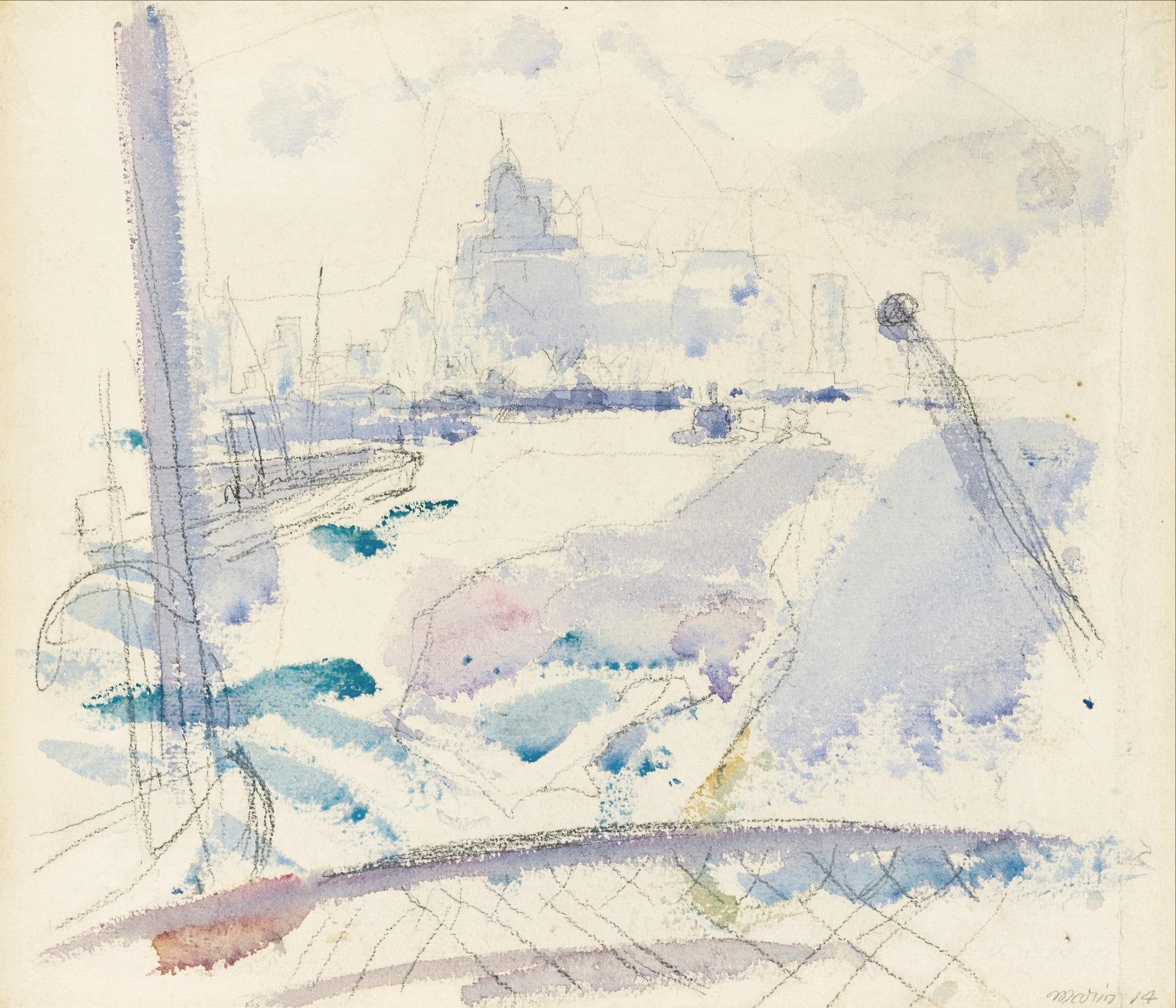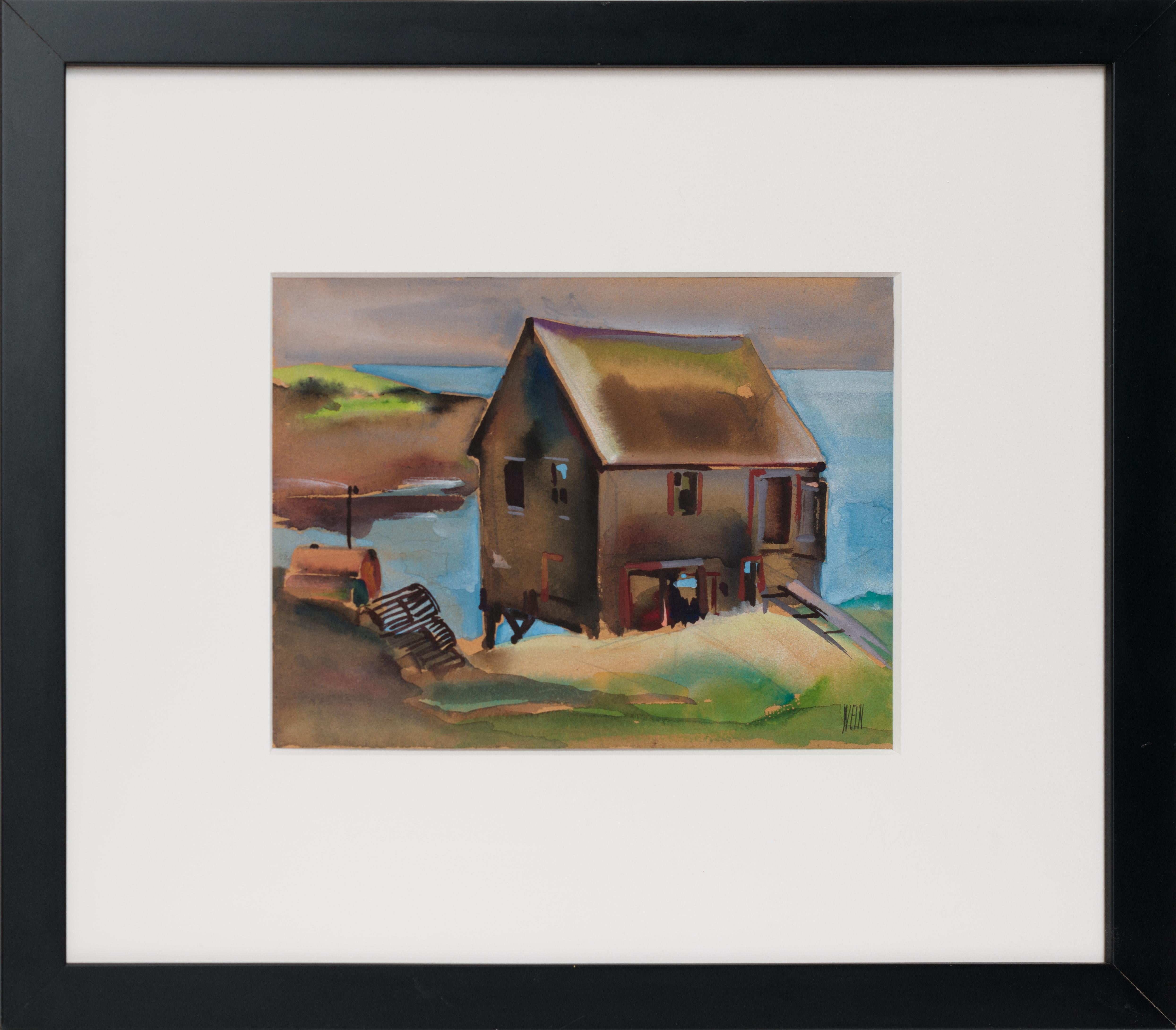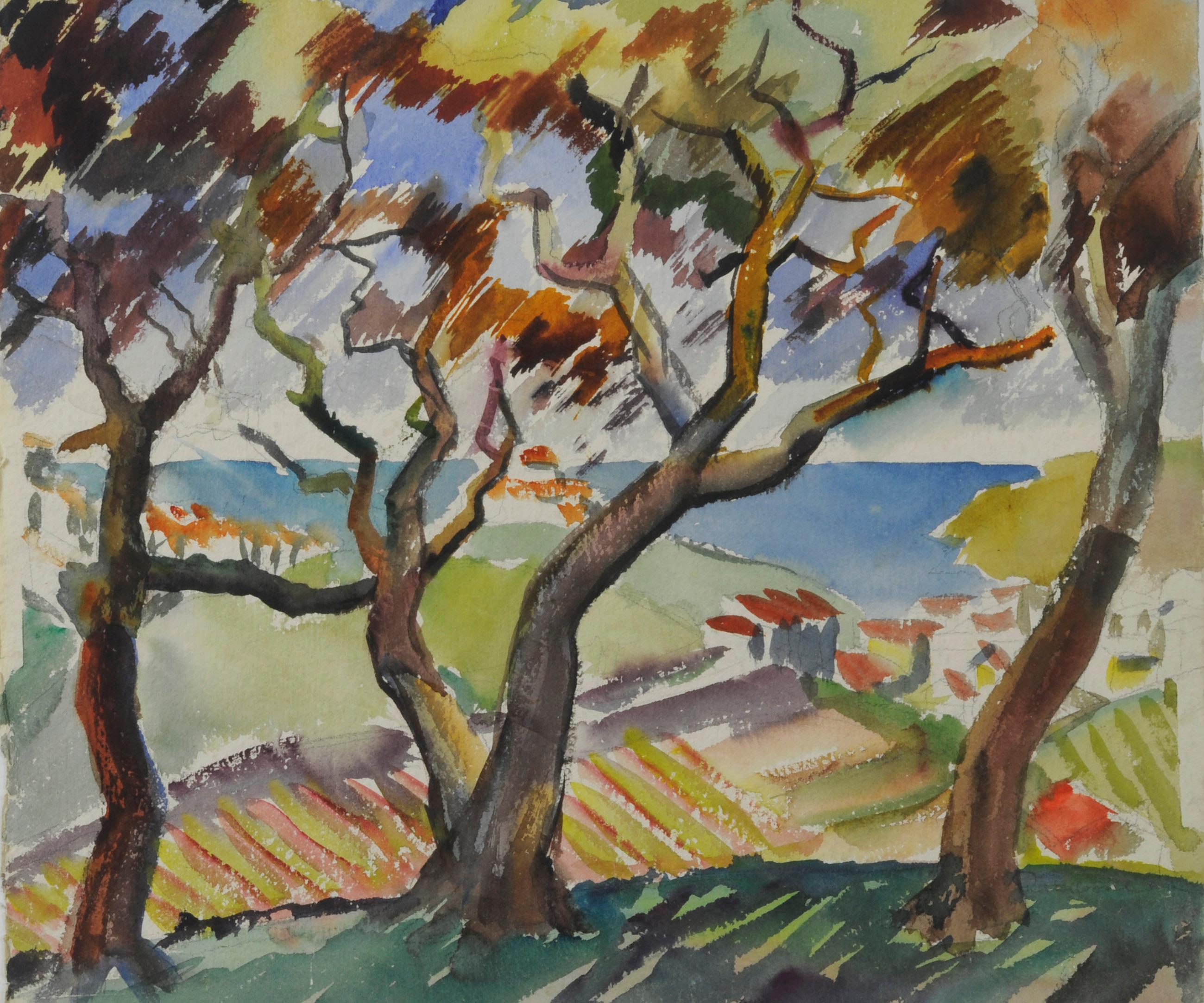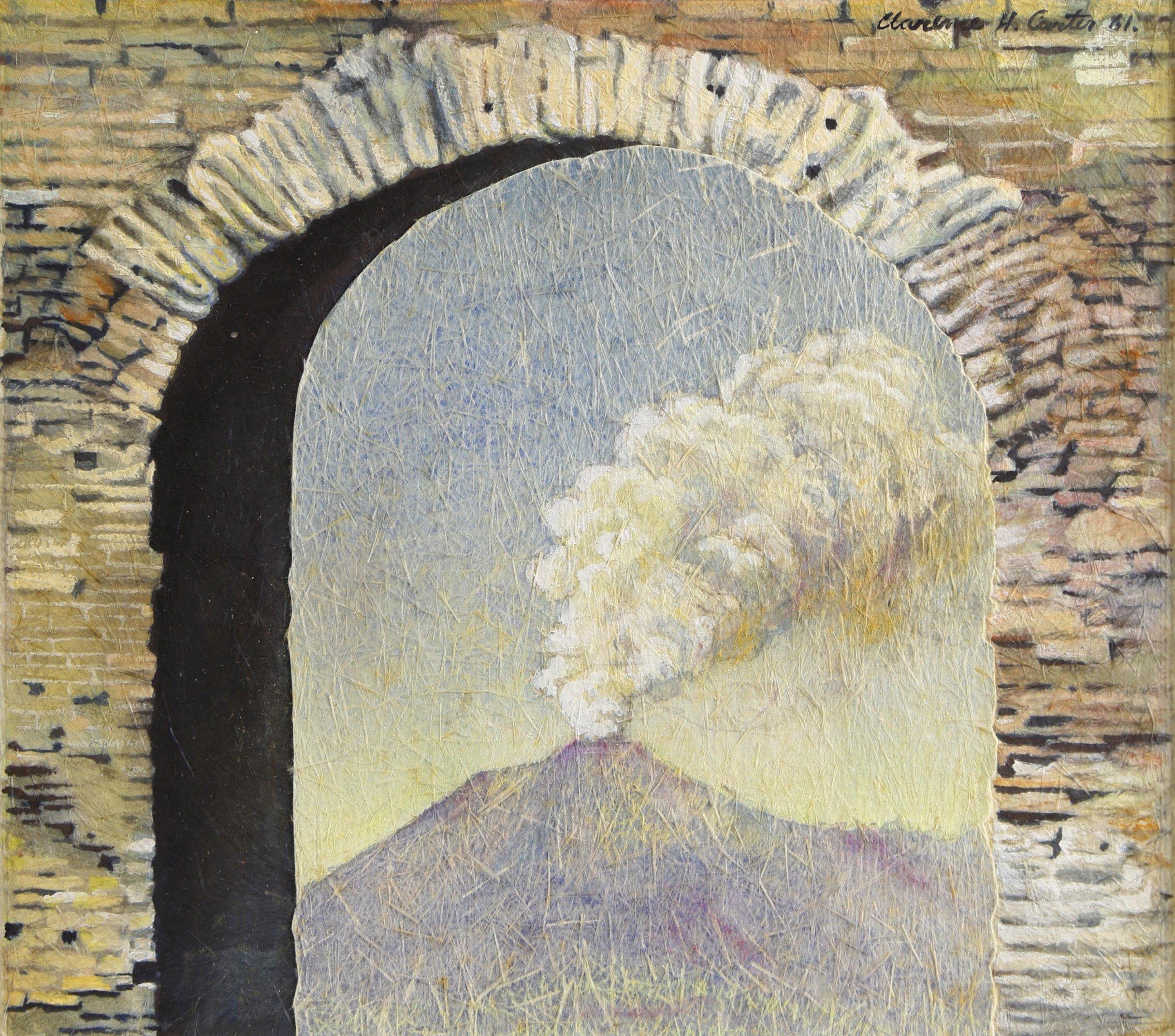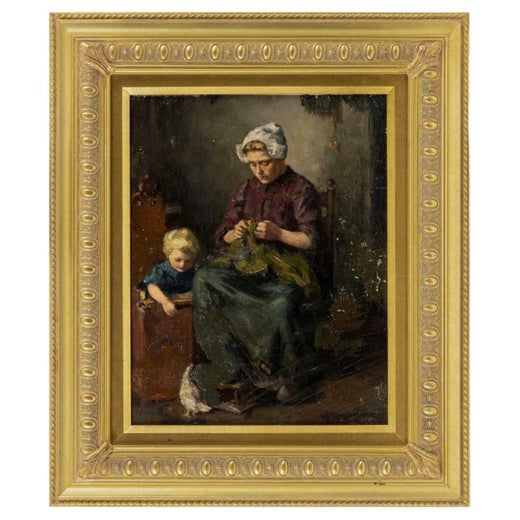Items Similar to Bangkok
Video Loading
Want more images or videos?
Request additional images or videos from the seller
1 of 11
Dong KingmanBangkok
About the Item
Bangkok
By Dong Kingman (American, 1911-2000)
Signed Lower Left
Unframed: 15" x 22"
Framed: 24" x 31"
Born in Oakland, CA on March 31, 1911. When Kingman was five, his family moved to Hong Kong where he grew up and attended Lingnan Grammar School. The headmaster of the school, Szetu Wei, had studied painting in Paris and recognized his budding artistic talent. For several years he trained young Kingman in both oriental and occidental approaches to painting. Returning to San Francisco in 1929, Kingman became active in the local art scene and began painting scenes of the city. His first solo show at the San Francisco Art Center in 1936 brought immediate recognition. During the 1930s he spent five years working on commissions for the Federal Public Works of Art Project. During WWII he created maps and charts for the O.S.S. After the war Kingman settled in NYC and taught at Columbia University. His paintings were used as backdrops for the movie "Flower Drum Song" and his watercolors were reproduced in Life and on the covers of Fortune and Holiday magazines. Kingman died in NYC on May 12, 2000. Member: American WC Society; NA (1951). Exh: SFMA Inaugural, 1935; Vallejo Public Library, 1935; Calif. WC Society, 1935-44; San Francisco Art Association, 1936 (1st prize); GGIE, 1939; San Diego FA Gallery, 1943; De Young Museum, 1945 (solo); County Fair (LA), 1949; Philadelphia WC Club, 1950 (medal); NAD, 1975 (gold medal). In: MM; SFMA; Boston Museum; Delaware Museum; Whitney Museum (NYC); MOMA; CHS; Brooklyn Museum; De Young Museum; San Diego Museum; Mills College (Oakland); AIC; NAD; Butler Art Inst. (Columbus, OH); Wilmington (DE) Society of FA; Toledo (OH) Museum; Dartmouth College; U.S. State Dept; Addison Gallery (Andover, MA); Evansville Museum.
- Creator:Dong Kingman (1911 - 2000, American, Chinese)
- Dimensions:Height: 15 in (38.1 cm)Width: 22 in (55.88 cm)
- Medium:
- Movement & Style:
- Period:
- Condition:
- Gallery Location:Missouri, MO
- Reference Number:1stDibs: LU747311640132
Dong Kingman
Born in Oakland, CA on March 31, 1911. When Kingman was five, his family moved to Hong Kong where he grew up and attended Lingnan Grammar School. The headmaster of the school, Szetu Wei, had studied painting in Paris and recognized his budding artistic talent. For several years he trained young Kingman in both oriental and occidental approaches to painting. Returning to San Francisco in 1929, Kingman became active in the local art scene and began painting scenes of the city. His first solo show at the San Francisco Art Center in 1936 brought immediate recognition. During the 1930s he spent five years working on commissions for the Federal Public Works of Art Project. During WWII he created maps and charts for the O.S.S. After the war Kingman settled in NYC and taught at Columbia University. His paintings were used as backdrops for the movie "Flower Drum Song" and his watercolors were reproduced in Life and on the covers of Fortune and Holiday magazines. Kingman died in NYC on May 12, 2000. Member: American WC Society; NA (1951). Exh: SFMA Inaugural, 1935; Vallejo Public Library, 1935; Calif. WC Society, 1935-44; San Francisco Art Association, 1936 (1st prize); GGIE, 1939; San Diego FA Gallery, 1943; De Young Museum, 1945 (solo); County Fair (LA), 1949; Philadelphia WC Club, 1950 (medal); NAD, 1975 (gold medal). In: MM; SFMA; Boston Museum; Delaware Museum; Whitney Museum (NYC); MOMA; CHS; Brooklyn Museum; De Young Museum; San Diego Museum; Mills College (Oakland); AIC; NAD; Butler Art Inst. (Columbus, OH); Wilmington (DE) Society of FA; Toledo (OH) Museum; Dartmouth College; U.S. State Dept; Addison Gallery (Andover, MA); Evansville Museum.
About the Seller
5.0
Vetted Seller
These experienced sellers undergo a comprehensive evaluation by our team of in-house experts.
Established in 1970
1stDibs seller since 2017
142 sales on 1stDibs
Typical response time: 20 hours
- ShippingRetrieving quote...Ships From: Missouri, MO
- Return PolicyA return for this item may be initiated within 2 days of delivery.
More From This SellerView All
- New York RooftopLocated in Missouri, MONew York Rooftop, 1963 Frank Stack (American, b. 1937) Signed and Dated Lower Right 14 x 18.75 inches 19 x 24 inches with frame Frank Stack was born in Ho...Category
1960s American Modern Landscape Drawings and Watercolors
MaterialsWatercolor
- GolfersBy Frederick ConwayLocated in Missouri, MOGolfers, 1928 Fred Conway (American, 1900-1973) Signed and Dated Lower Right 18.5 x 24.5 inches 30.5 x 37 inches with frame A member of the faculty of the Washington University Art ...Category
1920s American Modern Figurative Drawings and Watercolors
MaterialsPaper, Watercolor
- Old Mission Station, San Francisco, CaliforniaBy Dong KingmanLocated in Missouri, MODong Kingman (American 1911-2000) "Old Mission Station" c. 1950 watercolor on paper Signed *Fully illustrated in the book "Dong Kingman, Portraits of Cities" Sheet Size: 22 x 30 inches Framed Size: 32.5 x 40.5 inches The following obituary is from Dong Kingman Jr., son of the artist. DONG KINGMAN (1911-2000) Dong Kingman, the world-renowned artist and teacher, died in his sleep on May 12, 2000 at age 89 in his home in Manhattan. The cause was pancreatic cancer. Long acknowledged as an American watercolor master, he has received an extraordinary number of awards and honors throughout his 70-year career in the arts. Included are two Guggenheim fellowships in 1942 and 1943; the San Francisco Art Association First Purchase Prize, 1936; Audubon Artist Medal of Honor, 1946; Philadelphia Watercolor Club Joseph Pennel Memorial Medal, 1950; Metropolitan Museum of Art Award, and the National Academy Design 150th Anniversary Gold Medal Award, 1975. In 1987, the American Watercolor Society awarded Dong Kingman its highest honor, the Dolphin Medal, "for having made outstanding contributions to art especially to that of watercolor." His work is represented in the permanent collections of 50 museums and universities, including the Boston Museum of Fine Arts, M.H. deYoung Memorial Museum of Art, the Metropolitan Museum of Art, the Whitney Museum, Museum of Modern Art, Art Institute of Chicago, Pennsylvania Academy of Fine Arts, Sheldon Memorial Art Gallery and Sculpture Garden, Des Moines Art Center, Columbus Museum of Arts and Crafts, Brooklyn Museum and Hirshhorn Museum. Born in Oakland, California in 1911 of Chinese descent, Kingman moved to Hong Kong at age five. He studied art and calligraphy in his formative years at the Lingnan School. The painting master Szeto Wai had recently studied art in Paris and took a keen interest in young Dongs precocious talents. He taught him both Chinese classical and French Impressionist styles of painting. Kingman returned home to Oakland when he was 18 at the height of the Depression. He worked as a newsboy and dishwasher to make ends meet. When he was employed as a houseboy for the Drew family in San Francisco, he painted every spare moment. In a year, he created enough pictures to have a one-man show at the Art Center. It attracted the attention of San Francisco art critics who raved about Kingmans unique style. Wrote Junius Cravens of the San Francisco News: "That young Chinese artist is showing 20 of the freshest and most satisfying watercolors that have been seen hereabouts in many a day Kingman already has developed that universal quality which may place a sincere artist work above the limitations of either racial characteristics or schools. Kingmans art belongs to the world at large today." Dong Kingman became an overnight success. From 1936 to 1941, he was a project artist for WPA and became a pioneer for a new school of painting, the "California Style." His two Guggenheim fellowships enabled him to travel the country painting American scenes. His first one-man show in New York at Midtown Galleries in 1942 was well received in the media, including Time, Newsweek, the New Yorker and American Artist. M.H. de Young Memorial Museum in San Francisco held a major exhibit of his watercolors in 1945. In 1951, Midtown presented a 10-year retrospective of his work. Time Magazine wrote, "At age 40, Kingman is one of the worlds best watercolorists." Other retrospectives, including Corcoran in Washington,D.C. an d Witte Memorial Museum in San Antonio, were held for the artist. Kingman moved to Wildenstein (1958-1969) where he had successful exhibits in New York, London and Paris. Hammer Galleries exhibited his paintings in the 70s, and then the artist expanded his venues to the West Coast and Far East. During World War II, he served with the OSS in Washington, D.C. where he was a cartographer. After his honorable discharge, Kingman moved to Brooklyn Heights from San Francisco when he became a guest lecturer and then art instructor at Columbia University (1946-1958). Hunter College also appointed him instructor in watercolors and Chinese Art (1948-1953). His teaching career continued with the Famous Artists School, Westport, CT in 1953, joining such distinguished artists on the faculty as Will Barnet, Stuart Davis, Norman Rockwell and Ben Shahn. He also became a teaching member for 40 years for the Hewitt Painting Workshops, which conducts worldwide painting tours. He taught at the Academy of Art College in San Francisco, was a member of its board, and received an honorary doctorate from the Academy. In 1954, the U.S. Department of State invited Kingman to go on a cultural exchange program tour around the world to give exhibitions and lectures and to meet local artists. When he came home, he presented the State Department with a 40-foot long report on a scroll, which later appeared in LIFE Magazine. One of Kingman's most treasured experiences was his invitation by the Ministry of Culture of the Peoples Republic of China to exhibit in that country in 1981. He was the first American artist to be accorded a one-man show since diplomatic relations resumed. More than 100,000 visitors attended his exhibitions in Beijing, Hangzhou and Guangzhou and the retrospective received critical acclaim from the Chinese press. Noted the China Daily Mail, "Just as the master painters of the Song Dynasty roamed about mountain and stream to capture the rhythm of nature, Dong Kingman traveled the world capturing the dynamism of modern lifefamiliar scenes have been transformed into a vibrant new vision of life through color schemes with rhythms that play over the entire surface of the picture. The wind swept skies which enliven his watercolors remind us of the pleinairism of the French Impressionists." Kingman, who has been fascinated with movies since seeing his first film "The Thief of Baghdad...Category
1950s American Modern Landscape Drawings and Watercolors
MaterialsWatercolor
- Chinese Theater, Los AngelesBy Dong KingmanLocated in Missouri, MODong Kingman "Chinese Theater, Los Angeles" 1965 Watercolor on Paper Sheet Size: 15 x 22 inches Framed Size: approx 19 x 26 inches Dong Kingman, the world-renowned artist and teacher, died in his sleep on May 12, 2000 at age 89 in his home in Manhattan. The cause was pancreatic cancer. Long acknowledged as an American watercolor master, he has received an extraordinary number of awards and honors throughout his 70-year career in the arts. Included are two Guggenheim fellowships in 1942 and 1943; the San Francisco Art Association First Purchase Prize, 1936; Audubon Artist Medal of Honor, 1946; Philadelphia Watercolor Club Joseph Pennel Memorial Medal, 1950; Metropolitan Museum of Art Award, and the National Academy Design 150th Anniversary Gold Medal Award, 1975. In 1987, the American Watercolor Society awarded Dong Kingman its highest honor, the Dolphin Medal, "for having made outstanding contributions to art especially to that of watercolor." His work is represented in the permanent collections of 50 museums and universities, including the Boston Museum of Fine Arts, M.H. deYoung Memorial Museum of Art, the Metropolitan Museum of Art, the Whitney Museum, Museum of Modern Art, Art Institute of Chicago, Pennsylvania Academy of Fine Arts, Sheldon Memorial Art Gallery and Sculpture Garden, Des Moines Art Center, Columbus Museum of Arts and Crafts, Brooklyn Museum and Hirshhorn Museum. Born in Oakland, California in 1911 of Chinese descent, Kingman moved to Hong Kong at age five. He studied art and calligraphy in his formative years at the Lingnan School. The painting master Szeto Wai had recently studied art in Paris and took a keen interest in young Dongs precocious talents. He taught him both Chinese classical and French Impressionist styles of painting. Kingman returned home to Oakland when he was 18 at the height of the Depression. He worked as a newsboy and dishwasher to make ends meet. When he was employed as a houseboy for the Drew family in San Francisco, he painted every spare moment. In a year, he created enough pictures to have a one-man show at the Art Center. It attracted the attention of San Francisco art critics who raved about Kingmans unique style. Wrote Junius Cravens of the San Francisco News: "That young Chinese artist is showing 20 of the freshest and most satisfying watercolors that have been seen hereabouts in many a day Kingman already has developed that universal quality which may place a sincere artist work above the limitations of either racial characteristics or schools. Kingmans art belongs to the world at large today." Dong Kingman became an overnight success. From 1936 to 1941, he was a project artist for WPA and became a pioneer for a new school of painting, the "California Style." His two Guggenheim fellowships enabled him to travel the country painting American scenes. His first one-man show in New York at Midtown Galleries in 1942 was well received in the media, including Time, Newsweek, the New Yorker and American Artist. M.H. de Young Memorial Museum in San Francisco held a major exhibit of his watercolors in 1945. In 1951, Midtown presented a 10-year retrospective of his work. Time Magazine wrote, "At age 40, Kingman is one of the worlds best watercolorists." Other retrospectives, including Corcoran in Washington,D.C. an d Witte Memorial Museum in San Antonio, were held for the artist. Kingman moved to Wildenstein (1958-1969) where he had successful exhibits in New York, London and Paris. Hammer Galleries exhibited his paintings in the 70s, and then the artist expanded his venues to the West Coast and Far East. During World War II, he served with the OSS in Washington, D.C. where he was a cartographer. After his honorable discharge, Kingman moved to Brooklyn Heights from San Francisco when he became a guest lecturer and then art instructor at Columbia University (1946-1958). Hunter College also appointed him instructor in watercolors and Chinese Art (1948-1953). His teaching career continued with the Famous Artists School, Westport, CT in 1953, joining such distinguished artists on the faculty as Will Barnet, Stuart Davis, Norman Rockwell and Ben Shahn. He also became a teaching member for 40 years for the Hewitt Painting Workshops, which conducts worldwide painting tours. He taught at the Academy of Art College in San Francisco, was a member of its board, and received an honorary doctorate from the Academy. In 1954, the U.S. Department of State invited Kingman to go on a cultural exchange program tour around the world to give exhibitions and lectures and to meet local artists. When he came home, he presented the State Department with a 40-foot long report on a scroll, which later appeared in LIFE Magazine. One of Kingman's most treasured experiences was his invitation by the Ministry of Culture of the Peoples Republic of China to exhibit in that country in 1981. He was the first American artist to be accorded a one-man show since diplomatic relations resumed. More than 100,000 visitors attended his exhibitions in Beijing, Hangzhou and Guangzhou and the retrospective received critical acclaim from the Chinese press. Noted the China Daily Mail, "Just as the master painters of the Song Dynasty roamed about mountain and stream to capture the rhythm of nature, Dong Kingman traveled the world capturing the dynamism of modern lifefamiliar scenes have been transformed into a vibrant new vision of life through color schemes with rhythms that play over the entire surface of the picture. The wind swept skies which enliven his watercolors remind us of the pleinairism of the French Impressionists." Kingman, who has been fascinated with movies since seeing his first film "The Thief of Baghdad...Category
1960s American Modern Landscape Drawings and Watercolors
MaterialsWatercolor, Paper
- New York HarborBy Dong KingmanLocated in Missouri, MODong Kingman "New York Harbor" c. 1940s watercolor on paper Signed *This is fully illustrated in the book, "Dong Kingman An American Master" (see attached images). Sheet Size: 22 x 30 inches Framed Size: approx. 33.5 x 40.5 inches This is a wonderful painting by the legendary artist, Dong Kingman (1911-2000). Great period for the artist, with his bold color and whimsical approach. The following obituary is from Dong Kingman Jr., son of the artist: Dong Kingman, the world-renowned artist and teacher, died in his sleep on May 12, 2000 at age 89 in his home in Manhattan. The cause was pancreatic cancer. Long acknowledged as an American watercolor master, he has received an extraordinary number of awards and honors throughout his 70-year career in the arts. Included are two Guggenheim fellowships in 1942 and 1943; the San Francisco Art Association First Purchase Prize, 1936; Audubon Artist Medal of Honor, 1946; Philadelphia Watercolor Club Joseph Pennel Memorial Medal, 1950; Metropolitan Museum of Art Award, and the National Academy Design 150th Anniversary Gold Medal Award, 1975. In 1987, the American Watercolor Society awarded Dong Kingman its highest honor, the Dolphin Medal, "for having made outstanding contributions to art especially to that of watercolor." His work is represented in the permanent collections of 50 museums and universities, including the Boston Museum of Fine Arts, M.H. deYoung Memorial Museum of Art, the Metropolitan Museum of Art, the Whitney Museum, Museum of Modern Art, Art Institute of Chicago, Pennsylvania Academy of Fine Arts, Sheldon Memorial Art Gallery and Sculpture Garden, Des Moines Art Center, Columbus Museum of Arts and Crafts, Brooklyn Museum and Hirshhorn Museum. Born in Oakland, California in 1911 of Chinese descent, Kingman moved to Hong Kong at age five. He studied art and calligraphy in his formative years at the Lingnan School. The painting master Szeto Wai had recently studied art in Paris and took a keen interest in young Dongs precocious talents. He taught him both Chinese classical and French Impressionist styles of painting. Kingman returned home to Oakland when he was 18 at the height of the Depression. He worked as a newsboy and dishwasher to make ends meet. When he was employed as a houseboy for the Drew family in San Francisco, he painted every spare moment. In a year, he created enough pictures to have a one-man show at the Art Center. It attracted the attention of San Francisco art critics who raved about Kingmans unique style. Wrote Junius Cravens of the San Francisco News: "That young Chinese artist is showing 20 of the freshest and most satisfying watercolors that have been seen hereabouts in many a day Kingman already has developed that universal quality which may place a sincere artist work above the limitations of either racial characteristics or schools. Kingmans art belongs to the world at large today." Dong Kingman became an overnight success. From 1936 to 1941, he was a project artist for WPA and became a pioneer for a new school of painting, the "California Style." His two Guggenheim fellowships enabled him to travel the country painting American scenes. His first one-man show in New York at Midtown Galleries in 1942 was well received in the media, including Time, Newsweek, the New Yorker and American Artist. M.H. de Young Memorial Museum in San Francisco held a major exhibit of his watercolors in 1945. In 1951, Midtown presented a 10-year retrospective of his work. Time Magazine wrote, "At age 40, Kingman is one of the worlds best watercolorists." Other retrospectives, including Corcoran in Washington,D.C. an d Witte Memorial Museum in San Antonio, were held for the artist. Kingman moved to Wildenstein (1958-1969) where he had successful exhibits in New York, London and Paris. Hammer Galleries exhibited his paintings in the 70s, and then the artist expanded his venues to the West Coast and Far East. During World War II, he served with the OSS in Washington, D.C. where he was a cartographer. After his honorable discharge, Kingman moved to Brooklyn Heights from San Francisco when he became a guest lecturer and then art instructor at Columbia University (1946-1958). Hunter College also appointed him instructor in watercolors and Chinese Art (1948-1953). His teaching career continued with the Famous Artists School, Westport, CT in 1953, joining such distinguished artists on the faculty as Will Barnet, Stuart Davis, Norman Rockwell and Ben Shahn. He also became a teaching member for 40 years for the Hewitt Painting Workshops, which conducts worldwide painting tours. He taught at the Academy of Art College in San Francisco, was a member of its board, and received an honorary doctorate from the Academy. In 1954, the U.S. Department of State invited Kingman to go on a cultural exchange program tour around the world to give exhibitions and lectures and to meet local artists. When he came home, he presented the State Department with a 40-foot long report on a scroll, which later appeared in LIFE Magazine. One of Kingman's most treasured experiences was his invitation by the Ministry of Culture of the Peoples Republic of China to exhibit in that country in 1981. He was the first American artist to be accorded a one-man show since diplomatic relations resumed. More than 100,000 visitors attended his exhibitions in Beijing, Hangzhou and Guangzhou and the retrospective received critical acclaim from the Chinese press. Noted the China Daily Mail, "Just as the master painters of the Song Dynasty roamed about mountain and stream to capture the rhythm of nature, Dong Kingman traveled the world capturing the dynamism of modern lifefamiliar scenes have been transformed into a vibrant new vision of life through color schemes with rhythms that play over the entire surface of the picture. The wind swept skies which enliven his watercolors remind us of the pleinairism of the French Impressionists." Kingman, who has been fascinated with movies since seeing his first film "The Thief of Baghdad...Category
1940s American Modern Landscape Drawings and Watercolors
MaterialsWatercolor, Paper
- ZurichBy Dong KingmanLocated in Missouri, MOZurich By Dong Kingman (American, 1911-2000) Unframed: 22" x 15" Framed: 31" x 24" Signed Lower Right Born in Oakland, CA on March 31, 1911. When Kingman was five, his family moved to Hong Kong where he grew up and attended Lingnan Grammar School. The headmaster of the school, Szetu Wei, had studied painting in Paris and recognized his budding artistic talent. For several years he trained young Kingman in both oriental and occidental approaches to painting. Returning to San Francisco in 1929, Kingman became active in the local art scene and began painting scenes of the city. His first solo show at the San Francisco Art Center in 1936 brought immediate recognition. During the 1930s he spent five years working on commissions for the Federal Public Works of Art Project. During WWII he created maps and charts for the O.S.S. After the war Kingman settled in NYC and taught at Columbia University. His paintings were used as backdrops for the movie "Flower Drum Song...Category
20th Century American Modern Landscape Drawings and Watercolors
MaterialsWatercolor
You May Also Like
- Central Park in Fall, Framed Photorealist Watercolor PaintingLocated in Long Island City, NYArtist: Unknown Title: Central Park in Fall Medium: Watercolor on paper, signed lower right Image Size: 17.5 x 25 inches Frame Size: 28 x 35 inches Watercolor of The Mall in Centra...Category
1980s American Modern Landscape Drawings and Watercolors
MaterialsWatercolor
- "New York from the Ferry" John Marin, American Modernism Watercolor, CityscapeBy John MarinLocated in New York, NYJohn Marin New York from the Ferry, 1914 Signed and dated lower right Watercolor and graphite on paper 11 x 12 3/4 inches Provenance: An American Place, New York Kennedy Galleries, Inc., New York Christie's, New York, March 16, 1990, Lot 278 Private Collection (acquired from the above) Sotheby's New York, American Paintings, Drawings, & Sculpture, October 2, 2014, Lot 10 A major figure in early twentieth-century modernism, John Marin captured the colliding energies of the American urban scene and the vibrant contrasts of natural elements in the coastal landscape of Maine and other countryside locales. As one of the premier watercolorists of his era, Marin developed a light, spontaneous style ideally suited to conveying the freshness and flux of city and country experience -- his watercolors are often considered to match in strength those created by Winslow Homer in previous century. At the same time, Marin's sensitivity to mass, form, color, and line and their dynamic interchanges provided a precedent for the Abstract Expressionist movement of the late 1950s. Marin was born in Rutherford, New Jersey, to a family of European descent. After studying mechanical drawing and mathematics for half a year at the Stevens Institute of Technology in New York, Marin worked as a draftsman for several architects. It was not until he was almost thirty years old that he began to study art. He enrolled at the Pennsylvania Academy of the Fine Arts in Philadelphia from 1899 to 1901, and at the Art Students League in New York from 1901 to 1903, where his teachers were William Merritt Chase and Frank Vincent Dumond. While Marin was attending the League, the radical ideas of Arthur Wesley Dow were being disseminated and had an impact on the direction Marin would soon take in his art. Marin left for Europe in 1905. The next five years, which he spent abroad, were of tremendous importance to his career. He became a significant figure in the expatriate community in Paris, frequenting the Dôme, a café that served as a meeting place for artists and writers. While in Europe, Marin visited the Louvre and the Rijksmuseum in Amsterdam and, despite his claims that he had been indifferent to the Paris art world, he undoubtedly became aware of the art of Paul Cézanne and Henri Matisse. The works Marin created in Europe most strongly reflect the influence of James McNeill Whistler, especially the pastels he rendered in Venice. In the summer of 1909, Marin met Alfred Stieglitz in Paris. In February of the next year, Marin's work was shown along with that of Alfred Maurer at Stieglitz's gallery, 291. After returning to America in the following year, Marin became one of the most consistent members of Stieglitz's inner circle, showing at all three of his galleries -- 291, The Intimate Gallery, and An American Place. After 1910, Marin developed the routine that he would follow for the rest of his life, creating paintings, drawings, and prints in New York City and surrounding areas during the winter, and in the summer, traveling to the country, where he focused on the particular characteristics of the regions that he visited. He worked mainly in watercolor until 1928, when he began also to use oil. Marin never became purely abstract. He formulated a unique style melding influences of the art of the French Fauves, Cézanne, Matisse, and the French Cubists with a personal style of luminescent colors, agile brushwork, and a simultaneously delicate and strong handling. In city views, he used broken lines, a light touch, fluid color, and rhythmic compositions to convey what he described as the "great forces at work." He expressed the warring of the great and the small through relationships between masses. As he said, he sought to express the "pull forces" of the modern urban scene. Often portraying the new tall buildings of New York seen...Category
1910s American Modern Landscape Drawings and Watercolors
MaterialsPaper, Watercolor
- Monhegan House (Fisherman’s Shack)Located in Greenwich, CTA classically American modernist work depicting the fisherman's shack on Monhegan Island. Great for a beach house or New England home. Along the lines of an Edward Hopper or Winslo...Category
1950s American Modern Landscape Drawings and Watercolors
MaterialsWatercolor
- Trees Over the VineyardBy Robert HallowellLocated in Fairlawn, OHTrees Over the Vineyard Watercolor on heavy paper, c. 1930 Signed with the estate stamp verso (see photo) Sheet size: 16 1/2 x 19 1/8 inches Condition: Excellent Illustrated: Marbell...Category
1930s American Modern Landscape Drawings and Watercolors
MaterialsWatercolor
- Volcano and Arch, Taormina, Sicily, Italy, Mid Century Cleveland School ArtistBy Clarence Holbrook CarterLocated in Beachwood, OHClarence Holbrook Carter (American, 1904-2000) Volcano and Arch, Taormina, 1961 Watercolor on scintilla paper Signed and dated upper right 11 x 11 inches "My last year in art schoo...Category
1960s American Modern Figurative Drawings and Watercolors
MaterialsWatercolor
- Handsome Couple in Sailboat - Collier's Magazine IllustrationBy Earl Oliver HurstLocated in Miami, FLCollier's Magazine Illustration From the Estate of Charles Martignette. Work is framed in a period wood frame Watercolor on boardCategory
1940s American Modern Figurative Drawings and Watercolors
MaterialsBoard, Watercolor

